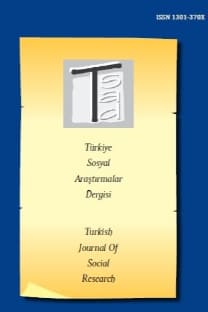BİLİŞİM TEKNOLOJİLERİ UYGULAMALARININ KURUM ÇALIŞANLARI ÜZERİNDEKİ ETKİLERİ: İZMİT BELEDİYESİ ÖRNEĞİ
Araştırmada, bilişim teknolojilerindeki uygulamaların İzmit Belediyesi çalışanlarına yaptığı etkinin ne olduğu cevaplanmaya çalışılmıştır. Bu çalışmada bilişim teknolojileri uygulamalarının çalışan performansına olan etkileri, iş tatmini, verimlilik, iletişimin etkin kullanılması gibi konulara yönelik bir alan çalışması amaçlanmıştır. Araştırma, 2018 yılı itibari ile İzmit Belediyesinde çalışan işçi, memur ve şirket personeline basit rastgele örneklem metoduyla uygulanmıştır. Bilişim teknolojilerindeki uygulamaların çalışanlar üzerindeki etkileri Mann Whitney U ve Kruskal Wallis testleri kullanılarak analiz edilmiştir. Bilişim teknolojileri uygulamalarının çalışanlar üzerindeki etkileri konusu üzerine yapılan bu araştırmada, anket yöntemi ile elde edilen verilerin uygulama sonuçlarının istatistiki analizleri yapılarak veriler elde edilmiştir. Bilişim teknolojileri uygulamalarının çalışan performansı, iş tatmini, verimlilik, iletişimin etkin kullanılması, iş yapma hızı üzerinde olumlu yönde etkili olduğu ve çalışanların demografik özelliklerine göre farklılaştığı sonucuna varılmıştır.
Anahtar Kelimeler:
değişim, kurumsal değişim, bilişim, bilişim teknolojileri
THE EFFECTS OF INFORMATION TECHNOLOGY IMPLEMENTATIONS ON INSTITUTIONAL EMPLOYEES: SAMPLE OF İZMİT MUNICIPALITY
In the research, the effects of the applications in information technologies on the employees of İzmit Municipality were tried to be answered.The aim of this study is to investigate the effects of information technologies applications on employee performance, job satisfaction, productivity, effective use of communication. The study was carried out with the help of simple random sampling method for the workers, civil servants and company personnel working in İzmit Municipality as of 2018. The effects of the applications of information technologies on the employees were analyzed by using Mann Whitney U and Kruskal Wallis tests. In this research on the effects of information technologies applications on employees, statistical analysis of the application results of the data obtained by the survey method were obtained and the data were obtained. It has been concluded that information technologies applications have positive effects on employee performance, job satisfaction, productivity, effective use of communication, speed of doing business, and differentiating according to demographic characteristics of employees.
Keywords:
change, institutional change, informatics, information technologies,
___
- AĞIR, A. (2012), Bilişim Toplumuna Geçiş Sürecinde Bilgi Yönetimi Yaklaşımı, İstanbul Üniversitesi İletişim Fakültesi Hakemli Dergisi, 30(0), 5- 17.
- CORNFORD, T., SHAIKH, M., (2013), Introduction To Information Systems, London: University of London Press.
- ÇELİK, A., AKGEMCİ, T., (2010), Yönetim Bilişim Sistemleri, Ankara: Gazi Kitabevi.
- DAVIS, F. D. (1989), Perceived Usefulness, Perceived Ease of Use, and User Acceptance of Information Technology, MIS Quarterly, 13(3), 319–340.
- DOSI, G., NELSON, R. (2010), Technical Change and Industrial Dynamics as Evolutionary Processes. Handbook in Economics of Innovation, 1(0), 52-127.
- DULKADİR, B., AKKOYUN, B., (2013), Bilişim Teknolojilerinin İşletme Performansı Üzerine Etkileri ve Gaziantep İlinde Tekstil Sektöründe Bir Araştırma, Gümüshane Üniversitesi Sosyal Bilimler Enstitüsü Elektronik Dergisi, 4(7), 72-90.
- GÖKÇEN, H. (2007). Yönetim Bilgi Sistemleri. Ankara: Palme Yayıncılık.
- GÜLEÇ, S., SANCAK, H. (2010), Küreselleşme - Bilgi Teknolojileri - Değişim: Türkiye’de Kamu Örgütlerinde Örgüt Yapısı Açısından Bir İnceleme, Kahramanmaraş Sütçü İmam Üniversitesi İktisat ve İdari Bilimler Fakültesi Dergisi, 10(3): 159-169.
- HARVEY, C., DENTON, J. (1999), To Come Of Age: The Antecedents Of Organizational Learning. Journal of Management Studies, 36(7), 910.
- KONGAR, E. (2008). 21. Yüzyılda Türkiye: 2000’li Yıllarda Türkiye’nin Toplumsal Yapısı. İstanbul: Remzi Kitabevi.
- LAUDON K. C., LAUDON J. P. (2011). Yönetim Bilişim Sistemleri: Dijital İşletmeyi Yönetme (YOZGAT, U., ÖĞÜT, A., TECİM, V., CURA, T., KARTALTEPE, N. B., Çev.), Ankara: Nobel Yayınevi.
- MATHESON, C. (2012), The Motivation of Public Sector Employees: An Outline of Six Orientations to Work, Administration and Society, 44(2), 207-237.
- PEREZ-VALLS, M., ORTEGA-EGEA, J. M., UBEDA, J. A. P. (2006). Relationship Between New Information Technologies and Flexible Organizational Form, IT-Enabled Strategic Management: Increasing Returns for the Organization, Zaiyong Tang, Bruce Walters. (Eds), Hersey: IDEA Group 304 Publishing.
- RITZER, G. (2011). Sosyoloji Kuramları, H. Hülür (çev.), Ankara: De Ki Basım Yayım.
- STAIR, R., REYNOLDS, G., (2011), Principles of Information Systems, Boston: TenthCengage Learning.
- ŞİMŞEK, Ş. (2002); Yönetim ve Organizasyon. Konya: Günay Ofset.
- TAPSCOTT, D., AGNEW, D. (1999), Governance in the Digital Economy, Finance & Development, 36(4), 34–37.
- ISSN: 1301-370X
- Başlangıç: 2015
- Yayıncı: AKADEMİSYENLER BİRLİĞİ DERNEĞİ
Sayıdaki Diğer Makaleler
ORTAÖĞRETİM TÜRK DİLİ VE EDEBİYATI DERSİ ÖĞRETİMPROGRAMLARININ KONUŞMA EĞİTİMİ AÇISINDANİNCELENMESİ
HALİT ZİYA'NIN SANAT YAZILARINDA MUSİKİ
PROGRAMLAMA ÖĞRETİMİNİN BİLGİ İŞLEMSEL DÜŞÜNME BECERİSİNE ETKİSİ
ULUSAL ÖZEL EĞİTİM KONGRESİ BİLDİRİLERİNDEKİ ARAŞTIRMA EĞİLİMLERİ: BİR İÇERİK ANALİZİ
COĞRAFYADA ALTERNATİF BİR TEMATİK HARİTALAMA TEKNİĞİ: ALAN KARTOGRAMLARI
KAVRAM BULMACALARININ 6. SINIF ÖĞRENCİLERİNİN SOSYAL BİLGİLER BAŞARISINA ETKİSİ
ÖZEL EĞİTİM BÖLÜMÜNDE ÖĞRENİM GÖREN ÖĞRETMEN ADAYLARININ ÖZ YETERLİK İNANÇLARININ BELİRLENMESİ
